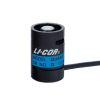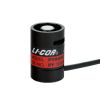LI-COR LI-191R Line PAR Sensors
Features
- Spatially averages PPFD over its 1m length
- Uses a 1m quartz rod under a diffuser to conduct light to a single Quantum sensor
- Improved water resistance for long-term outdoor deployment
- Free ground shipping
- Expedited repair and warranty service
- Lifetime technical support
- More
Overview
The LI-191R Line Quantum Sensor measures Photosynthetically Active Radiation (PAR) integrated over its 1-meter length. It is used to measure sunlight under a plant canopy, where the light field is non-uniform. It measures light in units of Photosynthetic Photon Flux Density (PPFD), which is expressed as μmol s-1 m-2.
Mechanics
The entire LI‑191R diffuser is sensitive to light over its 1-meter length. Since the diffuser is one continuous piece, the LI‑191R essentially integrates an infinite number of points over its surface into a single value that represents light from the entire 1-meter length. The diffuser and single photodiode in the LI‑191R provide stable, integrated measurements that are superior to averages provided by many linear sensors. Optical filters block radiation with wavelengths beyond 700 nm, which is critical for under-canopy measurements, where the ratio of infrared to visible light may be high.
- Absolute Calibration: ± 10% traceable to National Institute of Science and Technology (NIST). The LI-191 is calibrated via transfer calibration
- Sensitivity: Typically 7 μA per 1,000 μmol s-1 m-2
- Linearity: Maximum deviation of 1% up to 10,000 μmol s-1 m-2
- Response Time: 10 μs
- Temperature Dependence: ± 0.15% per °C maximum
- Cosine Correction: Acrylic diffuser
- Azimuth: < ± 2% error over 360° at 45° elevation
- Sensitivity Variation over Length: ± 7% maximum using a 2.54 cm (1”) wide beam from an incandescent light source.
- Sensing Area: 1 m × 12.7 mm (39.4” × 0.50”)
- Detector: High stability silicon photovoltaic detector (blue enhanced)
- Sensor Housing: Weatherproof anodized aluminum housing with acrylic diffuser and stainless steel hardware.
- Size: 121.3 L × 2.54 W × 2.54 cm D (47.7” × 1.0” × 1.0”)
- Weight: 1.4 kg (3.0 lbs.)
- Cable Length: 2 m, 5 m (6.5', 16.4')
- (1) LI-191R Line PAR Sensor
- (1) Bubble level
- (1) Detachable 10 ft. cable
- (1) Hard-sided carrying case
In The News
From Paddles to Phytoplankton: Studying Vermont’s Wildest Lakes
For six months of the year, Rachel Cray, a third-year PhD student at the Vermont Limnology Laboratory at the University of Vermont, lives between a microscope and her laptop, running data. For the other six months, she is hiking and canoeing four of Vermont’s lakes, collecting bi-weekly water samples. Cray studies algal phenology across four lakes in Vermont, US, that have low anthropogenic stress—or in other words, are very remote. Funded by the National Science Foundation Career Award to Dr. Mindy Morales, the lakes Cray researches part of the Vermont Sentinel Lakes Program, which studies 13 lakes in the area and, in turn, feeds into the Regional Monitoring Network, which operates in the Northeast and Midwest US.
Read MoreReimagining Water Filtration: How Monitoring and Science Enhance FloWater Filtration Systems
Over 50% of Americans think their tap water is unsafe , according to the Environmental Working Group (EWG). Other recent surveys have found that number to be as high as 70% of persons surveyed. Whether due to increased public awareness of water quality issues or confusion about how municipal water sources are regulated, there is a clear distrust of tap water in the United States. According to industry expert Rich Razgaitis, CEO and co-founder of the water purification company FloWater, this issue creates a damaging cycle. Razgaitis explained that the health and environmental problems associated with contaminated water aren’t the only issues. As people become increasingly aware that some tap water is unsafe, they resort to bottled water.
Read MoreMonitoring New Hampshire’s Aquatic Ecosystems: Continuous Data Collection in the Lamprey River Watershed
New Hampshire’s aquatic ecosystems provide a range of ecosystem services to the state and region. Resources and services like clean water, carbon storage, climate regulation, nutrient regulation, and opportunities for recreation all depend on New Hampshire’s aquatic ecosystems remaining healthy. Jody Potter, an analytical instrumentation scientist at the University of New Hampshire (UNH), is studying these aquatic ecosystems in hopes of developing an improved understanding of ecosystem services and their interactions with climate change, climate variability, and land use changes. [caption id="attachment_39799" align="alignnone" width="940"] Aquatic sensors in the Merrimack River in Bedford, NH, with I-293 in the background.
Read More




















